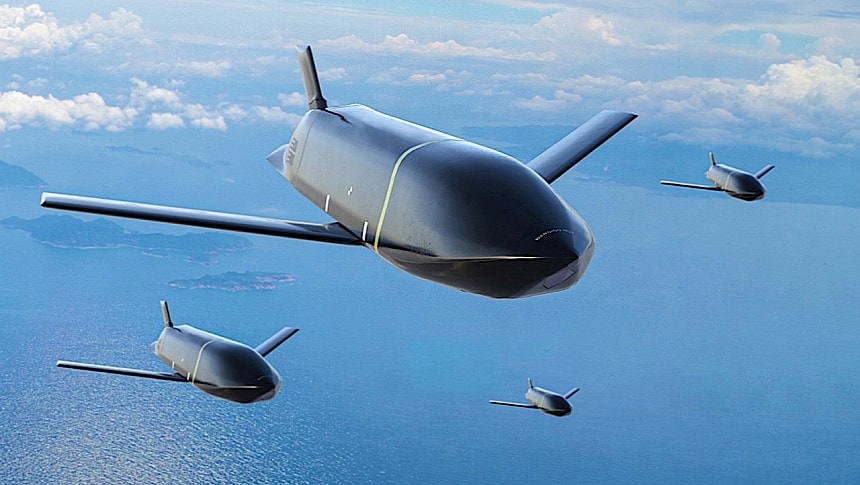Because of the advancements made in the field of air defense, present-day missiles are finding it increasingly difficult to reach their targets. As a result of that, defense contractors have begun investing heavily in new weapons systems capable of operating in denied environments. The Long-Range Anti-Ship Missile (LRASM) is one of America's solutions to this problem.
Defense contractor Lockheed Martin designs the weapon as part of the AGM-158 family of cruise missiles and as a derivation of the Joint Air-to-Surface Standoff Missile (JASSM). Production lines for it started rolling back in 2018, after Early Operational Capability (EOC) was achieved on a B-1B Lancer bomber.
The LRASM is by design an anti-ship missile, precision-guided and semi-autonomous. It is meant to be fired from aircraft and can travel for as much as 230 miles (370 km) to strike its target. The missile is not supersonic.
The range of the thing is quite impressive, but so are the weapon's capabilities. Because it is intelligent to some degree, the missile can penetrate “today's sophisticated integrated air defense environments" generated by enemy ships and strike with a lethality "no other weapon in the inventory can provide." That would the power of a 1,000-pound (454 kg) warhead.
It's not public knowledge how the missile works in denied areas, but Lockheed Martin speaks of precision routing, guidance and stealth, as well as the ability for the LRASM to fly regardless of weather conditions and time of day.
As said, the missile was already integrated with the B-1B six years ago, and in 2019 the same thing happened with the F/A-18E/F aircraft flown by the U.S. Navy. The missile is also being integrated with the F-35.
It's unclear which of these aircraft were used during what Lockheed Martin calls a historic test of the LRASM that took place recently in an undisclosed location. The defense contractor does not reveal the details of the test, but the “historic" event it mentions probably has to do with the fact that four of these missiles were in flight at the same time.
The Navy calls the run an Integrated Test Event, and it's the 12th to be conducted with the LRASM. It was meant to "demonstrate the weapon's inherent high-end lethality from mission planning through kill chain integration and its effects on the target,” but we're not told exactly what that means. The test was deemed a success by the parties involved.
Lockheed Martin has a contract to deliver 120 of these missiles to the American military. The company says it is also working on a surface-launch variant of the weapon, but does not reveal when we should expect it to become a reality.
Because the missile is so smart, the military believes that its deployment will not only give the Navy a stronger punch but will also remove some of the dependence on Intelligence, Surveillance and Reconnaissance drones, network links, and GPS navigation when trying to hit a target.
The LRASM is by design an anti-ship missile, precision-guided and semi-autonomous. It is meant to be fired from aircraft and can travel for as much as 230 miles (370 km) to strike its target. The missile is not supersonic.
The range of the thing is quite impressive, but so are the weapon's capabilities. Because it is intelligent to some degree, the missile can penetrate “today's sophisticated integrated air defense environments" generated by enemy ships and strike with a lethality "no other weapon in the inventory can provide." That would the power of a 1,000-pound (454 kg) warhead.
It's not public knowledge how the missile works in denied areas, but Lockheed Martin speaks of precision routing, guidance and stealth, as well as the ability for the LRASM to fly regardless of weather conditions and time of day.
As said, the missile was already integrated with the B-1B six years ago, and in 2019 the same thing happened with the F/A-18E/F aircraft flown by the U.S. Navy. The missile is also being integrated with the F-35.
It's unclear which of these aircraft were used during what Lockheed Martin calls a historic test of the LRASM that took place recently in an undisclosed location. The defense contractor does not reveal the details of the test, but the “historic" event it mentions probably has to do with the fact that four of these missiles were in flight at the same time.
The Navy calls the run an Integrated Test Event, and it's the 12th to be conducted with the LRASM. It was meant to "demonstrate the weapon's inherent high-end lethality from mission planning through kill chain integration and its effects on the target,” but we're not told exactly what that means. The test was deemed a success by the parties involved.
Lockheed Martin has a contract to deliver 120 of these missiles to the American military. The company says it is also working on a surface-launch variant of the weapon, but does not reveal when we should expect it to become a reality.
Because the missile is so smart, the military believes that its deployment will not only give the Navy a stronger punch but will also remove some of the dependence on Intelligence, Surveillance and Reconnaissance drones, network links, and GPS navigation when trying to hit a target.







